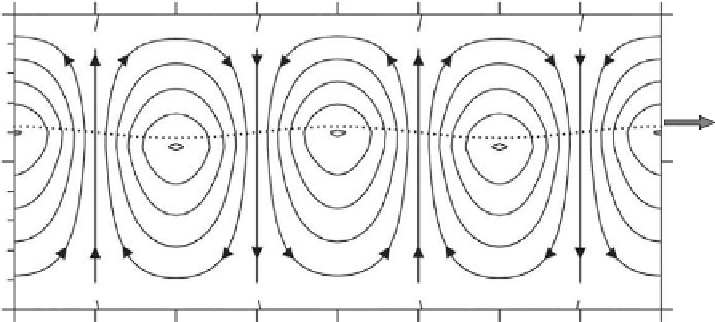Geoscience Reference
In-Depth Information
0
DIV
CON
CON
DIV
c
-0.5
CON
DIV
CON
DIV
-1.0
0
0.25
0.5
0.75
1
1.25
1.5
1.75
2
x/
λ
Figure 4.8
A snapshot of the instantaneous streamlines in a long internal wave with amplitude
a
¼
¼
1 metre travelling from left to right through a two-layer ocean. The wavelength is l
3000
metres, the water depth is h
¼
100 metres so that kh
¼
2ph/l
¼
0.21 and the upper layer
has a depth of h
1
¼
40 metres. The thick grey line indicates the displacement of the interface.
Notice the regions of convergence (CON) and divergence (DIV) in the surface flow.
This streamline picture is obtained from the velocity potential of
Equation (4.17)
.
waves
(Section 4.1.3)
, water particles will sample the velocity along their orbital
trajectory where the velocity differs from that at their mean position. As a result,
the Lagrangian (particle) velocity will differ from the Eulerian (fixed point) velocity
and the orbits will not be closed: the particles will, therefore, 'drift'. This rectified
flow is analogous to the Stokes drift of surface waves and results in an integrated
volume transport V
I
in the direction of wave advance given by:
1
2
kA
0
c
V
I
¼
ð
coth kh
1
þ
coth kh
2
Þ
ð
4
:
22
Þ
where the two terms represent transport in the upper and lower layer respectively.
Note that for deep water (kh
1 so that transport in the lower layer is
the same as that for a surface wave (see
Section 4.1.3
).
At the surface (z
≫
1), coth kh
2
!
0, so, we might deduce that there
p. 169) that there is very small displacement of the surface which is out of phase with
the interface movement and smaller by a factor of
¼
0) the vertical velocity w
¼
∼ D
r/r
0
1/1000 so that, in many
situations, it can be neglected.
An interesting property of propagating internal waves is that the surface flow
is convergent (
@
@
<
@
@
>
0) over the alternate nodes of z.
You can see this pattern of alternate convergence and divergence in
Fig. 4.8
which
shows the instantaneous velocity field in a propagating internal wave as streamlines
of the flow. Buoyant material at the surface tends to accumulate in the convergences,
creating transverse bands at intervals of one wavelength along the direction of
propagation. Such regular bands of surface material can be useful indicators of the
u/
x
0) and divergent (
u/
x








Search WWH ::

Custom Search